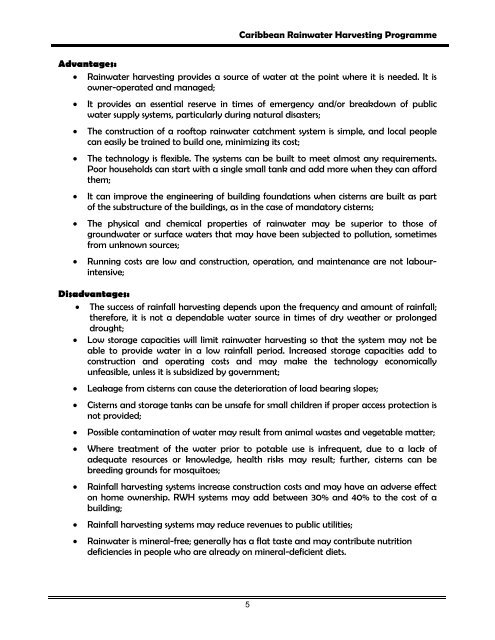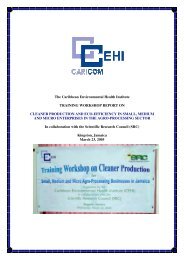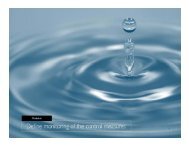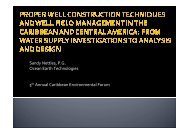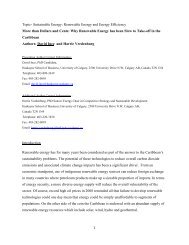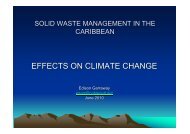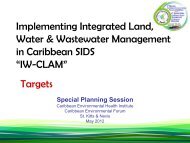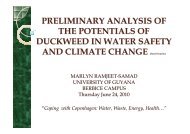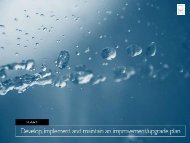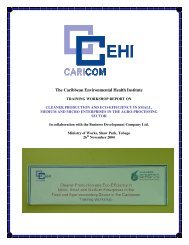A programme for Promoting Rainwater Harvesting in the Caribbean
A programme for Promoting Rainwater Harvesting in the Caribbean
A programme for Promoting Rainwater Harvesting in the Caribbean
Create successful ePaper yourself
Turn your PDF publications into a flip-book with our unique Google optimized e-Paper software.
<strong>Caribbean</strong> <strong>Ra<strong>in</strong>water</strong> <strong>Harvest<strong>in</strong>g</strong> ProgrammeAdvantages:• <strong>Ra<strong>in</strong>water</strong> harvest<strong>in</strong>g provides a source of water at <strong>the</strong> po<strong>in</strong>t where it is needed. It isowner-operated and managed;• It provides an essential reserve <strong>in</strong> times of emergency and/or breakdown of publicwater supply systems, particularly dur<strong>in</strong>g natural disasters;• The construction of a rooftop ra<strong>in</strong>water catchment system is simple, and local peoplecan easily be tra<strong>in</strong>ed to build one, m<strong>in</strong>imiz<strong>in</strong>g its cost;• The technology is flexible. The systems can be built to meet almost any requirements.Poor households can start with a s<strong>in</strong>gle small tank and add more when <strong>the</strong>y can af<strong>for</strong>d<strong>the</strong>m;• It can improve <strong>the</strong> eng<strong>in</strong>eer<strong>in</strong>g of build<strong>in</strong>g foundations when cisterns are built as partof <strong>the</strong> substructure of <strong>the</strong> build<strong>in</strong>gs, as <strong>in</strong> <strong>the</strong> case of mandatory cisterns;• The physical and chemical properties of ra<strong>in</strong>water may be superior to those ofgroundwater or surface waters that may have been subjected to pollution, sometimesfrom unknown sources;• Runn<strong>in</strong>g costs are low and construction, operation, and ma<strong>in</strong>tenance are not labour<strong>in</strong>tensive;Disadvantages:• The success of ra<strong>in</strong>fall harvest<strong>in</strong>g depends upon <strong>the</strong> frequency and amount of ra<strong>in</strong>fall;<strong>the</strong>re<strong>for</strong>e, it is not a dependable water source <strong>in</strong> times of dry wea<strong>the</strong>r or prolongeddrought;• Low storage capacities will limit ra<strong>in</strong>water harvest<strong>in</strong>g so that <strong>the</strong> system may not beable to provide water <strong>in</strong> a low ra<strong>in</strong>fall period. Increased storage capacities add toconstruction and operat<strong>in</strong>g costs and may make <strong>the</strong> technology economicallyunfeasible, unless it is subsidized by government;• Leakage from cisterns can cause <strong>the</strong> deterioration of load bear<strong>in</strong>g slopes;• Cisterns and storage tanks can be unsafe <strong>for</strong> small children if proper access protection isnot provided;• Possible contam<strong>in</strong>ation of water may result from animal wastes and vegetable matter;• Where treatment of <strong>the</strong> water prior to potable use is <strong>in</strong>frequent, due to a lack ofadequate resources or knowledge, health risks may result; fur<strong>the</strong>r, cisterns can bebreed<strong>in</strong>g grounds <strong>for</strong> mosquitoes;• Ra<strong>in</strong>fall harvest<strong>in</strong>g systems <strong>in</strong>crease construction costs and may have an adverse effecton home ownership. RWH systems may add between 30% and 40% to <strong>the</strong> cost of abuild<strong>in</strong>g;• Ra<strong>in</strong>fall harvest<strong>in</strong>g systems may reduce revenues to public utilities;• <strong>Ra<strong>in</strong>water</strong> is m<strong>in</strong>eral-free; generally has a flat taste and may contribute nutritiondeficiencies <strong>in</strong> people who are already on m<strong>in</strong>eral-deficient diets.5


